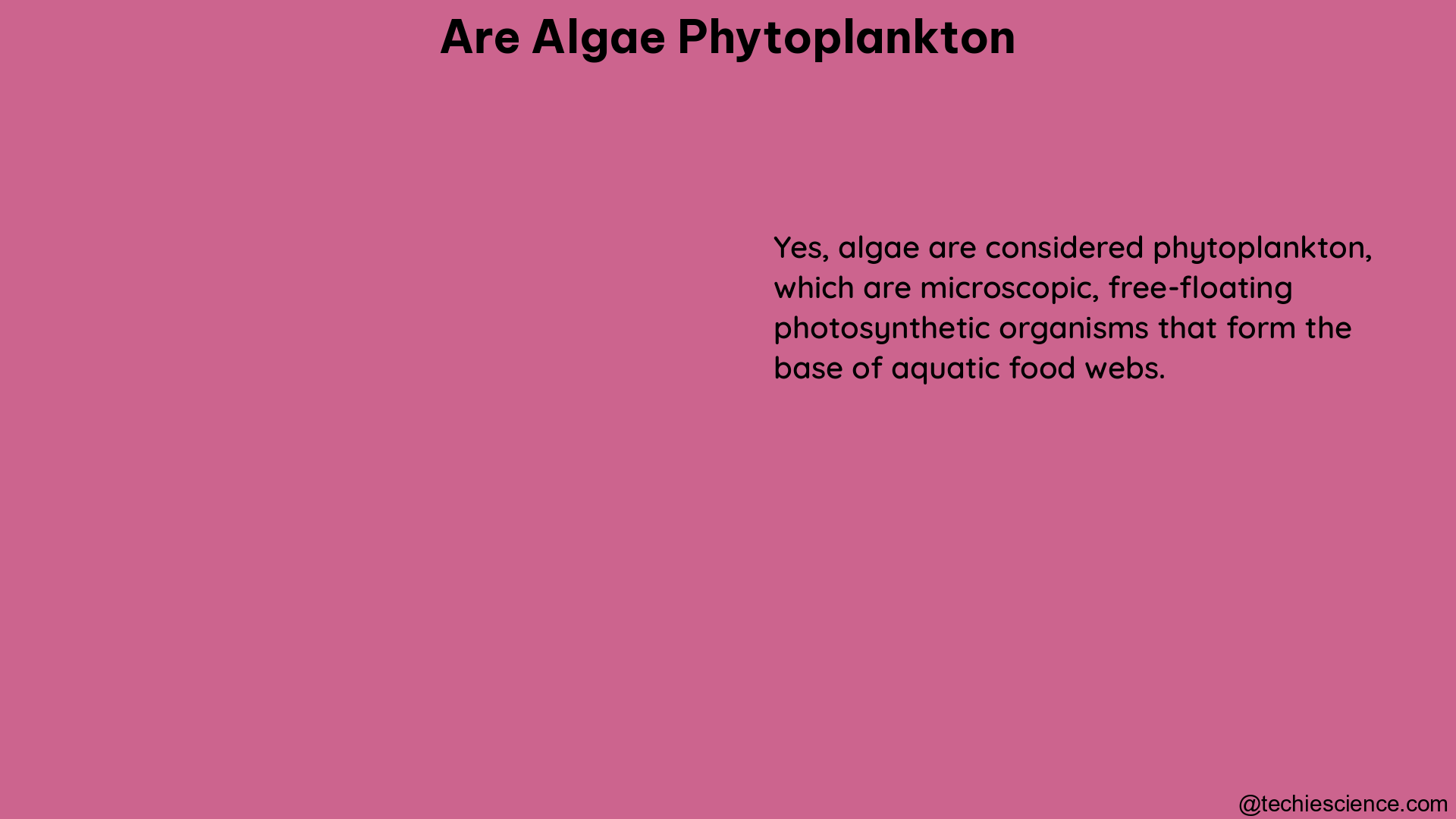Phytoplankton, the microscopic powerhouses of aquatic ecosystems, are responsible for producing half of the world’s oxygen through photosynthesis. These diverse organisms are not only crucial for maintaining the delicate balance of our planet’s ecosystems but also serve as valuable indicators of water quality. In this comprehensive guide, we delve into the intricate details of algae phytoplankton, exploring their biological specifications, theoretical explanations, and measurable, quantifiable data.
Biological Specifications of Algae Phytoplankton
Phytoplankton are a diverse group of organisms, with over 300 taxa identified in north-temperate lakes alone. These microscopic marvels can be classified into various groups, each with its unique characteristics and environmental preferences.
Cyanobacteria
Cyanobacteria, also known as blue-green algae, are gram-negative bacteria capable of photosynthesis. They are unique in their ability to fix atmospheric nitrogen, making them essential contributors to the nitrogen cycle in aquatic ecosystems. However, some species of Cyanobacteria can produce toxins that can be harmful to both wildlife and humans.
Cyanobacteria are known to thrive in nutrient-rich environments, and their abundance can be an indicator of eutrophication. They can form dense blooms that can disrupt the delicate balance of aquatic ecosystems, leading to the depletion of dissolved oxygen and the release of toxins. The ability of Cyanobacteria to produce toxins, such as microcystins and cylindrospermopsins, poses a significant threat to human and animal health, making them a subject of intense research and monitoring.
Chlorophyta
Chlorophyta, or green algae, are characterized by their chlorophyll a and b pigments. They are primarily found in freshwater environments and play a significant role in the carbon cycle. Some species of Chlorophyta can form colonies or filaments, while others exist as individual cells.
Green algae are known for their versatility and adaptability. They can thrive in a wide range of environmental conditions, from nutrient-rich to nutrient-poor waters. Some species of Chlorophyta, such as Chlamydomonas and Volvox, are capable of forming colonies or multicellular structures, which can provide them with a competitive advantage in certain environments.
Bacillariophyta
Bacillariophyta, or diatoms, are unicellular algae encased in a silica shell. They are abundant in both freshwater and marine environments and are essential contributors to the global carbon cycle. Diatoms are also valuable indicators of water quality, with some species tolerating high levels of pollution and others being highly sensitive.
Diatoms are known for their intricate and diverse cell wall structures, which are composed of silica. These silica shells, or frustules, are often used in the identification and classification of diatom species. Diatoms are particularly sensitive to changes in water chemistry, such as pH and nutrient levels, making them excellent bioindicators of water quality.
Euglenophyta
Euglenophyta, or euglenoids, are unicellular algae characterized by their flagella, which they use for movement. They are primarily found in freshwater environments and are capable of both photosynthesis and heterotrophy, making them facultative autotrophs. Some species of Euglenophyta can produce toxins that can be harmful to other organisms.
Euglenoids are known for their unique cellular structure, which includes a complex feeding apparatus called a “feeding groove” or “reservoir.” This structure allows them to consume a variety of organic compounds, including bacteria and other small particles, in addition to performing photosynthesis. Some species of Euglenophyta, such as Euglena, are also known for their ability to change shape and move in response to environmental cues.
Theoretical Explanations

Phytoplankton photosynthesis is influenced by various factors, including irradiance, temperature, and nutrient availability. The relationship between photosynthesis and irradiance, in particular, is complex, with different species exhibiting different responses.
Photosynthesis-Irradiance (P-I) Models
P-I models are used to quantify the relationship between photosynthesis and irradiance. These models describe the photosynthetic performance of phytoplankton as a function of irradiance. The most widely applied models for phytoplankton include the Ye model (model 4), which was originally developed for higher plants, and three other models specifically designed for phytoplankton (models 1, 2, and 3).
The Ye model (model 4) has been found to provide the best fit for the P-I curves of various phytoplankton species, including those isolated from the ocean and lakes. This model is a semi-mechanistic model that characterizes and simulates P-I curves of phytoplankton, making it a valuable tool for understanding and predicting phytoplankton photosynthesis.
The Ye model (model 4) is expressed as:
P = Pmax * (1 – exp(-α * I / Pmax)) * exp(-β * I / Pmax)
Where:
– P is the photosynthetic rate
– Pmax is the maximum photosynthetic rate
– α is the initial slope of the P-I curve (photosynthetic efficiency)
– β is the photoinhibition parameter
– I is the irradiance
This model captures the key features of phytoplankton photosynthesis, including the initial linear increase in photosynthesis with increasing irradiance, the saturation of photosynthesis at high irradiance, and the potential for photoinhibition at very high irradiance levels.
Measurable, Quantifiable Data on Algae Phytoplankton
- Phytoplankton biomass: The biomass of phytoplankton can be quantified using various methods, including direct counting, biovolume calculations, and chlorophyll a measurements.
- Direct counting: Phytoplankton cells can be counted using a microscope and a counting chamber, such as a hemocytometer or a Sedgewick-Rafter cell. This method provides a direct measure of the number of cells per unit volume.
- Biovolume calculations: The biovolume of phytoplankton can be estimated by measuring the size and shape of individual cells and then calculating the total biovolume per unit volume.
-
Chlorophyll a measurements: Chlorophyll a, the primary photosynthetic pigment in phytoplankton, can be extracted and measured using spectrophotometric or fluorometric techniques. Chlorophyll a concentration is often used as a proxy for phytoplankton biomass.
-
Phytoplankton diversity: The diversity of phytoplankton can be quantified using various indices, such as the Shannon-Wiener index and the Simpson index.
- Shannon-Wiener index (H’): This index takes into account both the number of species and the relative abundance of each species. It is calculated as H’ = -Σ(pi * ln pi), where pi is the proportion of the ith species.
-
Simpson index (D): This index measures the probability that two individuals randomly selected from a sample will belong to the same species. It is calculated as D = Σ(ni * (ni – 1)) / (N * (N – 1)), where ni is the number of individuals of the ith species and N is the total number of individuals.
-
Phytoplankton photosynthesis: The photosynthetic performance of phytoplankton can be quantified using P-I models, such as the Ye model (model 4), which provides estimates of photosynthetic parameters, such as the maximum photosynthetic rate (Pmax) and the light saturation point (Ic).
- Maximum photosynthetic rate (Pmax): This parameter represents the maximum rate of photosynthesis that a phytoplankton species can achieve under optimal conditions.
- Light saturation point (Ic): This parameter represents the irradiance level at which photosynthesis becomes light-saturated, and further increases in irradiance do not result in increased photosynthesis.
By understanding and quantifying these various aspects of algae phytoplankton, researchers and environmental managers can gain valuable insights into the health and functioning of aquatic ecosystems, as well as the potential impacts of environmental stressors on these crucial organisms.
References
- Wei, J., Finlay, K., Beisner, B. E., & Longhi, M. L. (2021). Quantifying seasonal succession of phytoplankton trait-environment relationships in north-temperate lakes. Limnology and Oceanography, 66(1), 115-131.
- Zhao, C. S., Zeng, H., Xu, X. Y., Xie, P., & Chen, J. (2019). Quantitative assessment of the effects of human activities on phytoplankton communities in lakes and reservoirs. Science of the Total Environment, 650, 288-299.
- Li, Y., Huang, W., Ren, J., Wang, X., & Xie, W. (2020). Quantifying photosynthetic performance of phytoplankton based on P-I models. Algal Research, 47, 101692.
- Ye, Q. (1997). A semi-mechanistic model for the photosynthesis-irradiance curve. Photosynthetica, 33(2), 229-234.

Hi…I am Arti Pandey, have a Master’s degree in Biotechnology. I am an academic writer in Lambdageeks and also a beginner Korean learner. I love to explore new cultures, places, and food. I love photography and had a keen interest in creative writing.